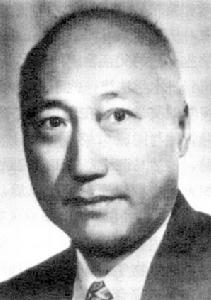
Summary
Hsien Wu (simplified Chinese: 吴宪; traditional Chinese: 吳憲; pinyin: Wú Xiàn; 24 November 1893 – 8 August 1959) was a Chinese biochemist and geneticist. He was the first to propose that protein denaturation was a purely conformational change, i.e., corresponded to protein unfolding and not to some chemical alteration of the protein.[1] This crucial idea was popularized later by Linus Pauling and Alfred Mirsky.[2]
Wu Hsien | |
|---|---|
 | |
| Born | 24 November 1893 |
| Died | 8 August 1959 (aged 65) Boston, Massachusetts, United States |
| Nationality | China and United States of America |
| Alma mater | Harvard University Massachusetts Institute of Technology |
| Scientific career | |
| Fields | Protein science Biochemistry |
| Institutions | University of Alabama Peking Union Medical College |
Wu was born in Fuzhou, Fujian, China. He studied at the Massachusetts Institute of Technology (undergraduate), and then trained at Harvard University (graduate) under Otto Folin, developing the first small-volume (≥ 0.1-mL sample) assay for blood sugar (Folin-Wu method).[3] Wu then returned to China to a position at Peking Union Medical College, becoming head of the biochemistry department in 1924. At the end of that year, he married his research assistant Daisy Yen and would continue collaborating with her until his death in 1959.[4]
Wu left China in 1947 to reside in the United States; his wife and children joined him in 1949.
Wu's son, Ray J. Wu, became the Liberty Hyde Bailey Professor of Molecular Genetics and Biology at Cornell University, and developed the first method for sequencing DNA [5] and studying transgenic plants.
References edit
- ^ Wu, H (1931). "Studies on Denaturation of Proteins. XIII. A Theory of Denaturation". Chinese Journal of Physiology. 5: 321–344. Preliminary reports were presented before the XIIIth International Congress of Physiology at Boston (19–24 August 1929) and in the October 1929 issue of the American Journal of Physiology.
- ^ Mirsky, AE; Pauling L (1936). "On the Structure of Native, Denatured, and Coagulated Proteins" (PDF). Proceedings of the National Academy of Sciences USA. 22 (7): 439–447. Bibcode:1936PNAS...22..439M. doi:10.1073/pnas.22.7.439. PMC 1076802. PMID 16577722.
- ^ Annesley, Thomas (2020). "We Know Folin, But Who Was Wu?". Clinical Chemistry. 66 (12): 1577–1578. doi:10.1093/clinchem/hvaa152. PMID 33263119.
- ^ 曹 (Cao), 育 (Yu) (7 March 2008). 屈 (Qu), 宝坤 (Baokun) (ed.). "最早在国内从事生物化学研究的女学者——吴严彩韵" [Daisy Yen Wu—The First Woman Scholar in China Engaged in Biochemical Research]. 中国科技史料 (in Chinese). Beijing: Institute of the History of Natural Sciences, Chinese Academy of Sciences. Chinese Library Classification Number K826.1. Archived from the original on 10 September 2012. Retrieved 4 October 2020.
- ^ Wu, R. (August 1970). "Nucleotide sequence analysis of DNA. I. Partial sequence of the cohesive ends of bacteriophage lambda and 186 DNA". Journal of Molecular Biology. 51 (3): 501–521. doi:10.1016/0022-2836(70)90004-5. ISSN 0022-2836. PMID 4321727.
Further reading edit
- Edsall, JT (1995). Hsien Wu and the First Theory of Protein Denaturation. Advances in Protein Chemistry. Vol. 46. pp. 1–5. doi:10.1016/S0065-3233(08)60329-0. ISBN 978-0-12-034246-4.
- Bishop, Charles (1 February 1982). "Hsien Wu (1893-1959): A Biographical Sketch". Clinical Chemistry. 28 (2): 378–80. doi:10.1093/clinchem/28.2.378. PMID 7035008.
- Wu, DY (1959). Hsien Wu 1893-1959: In Loving Memory. Boston: published privately.


